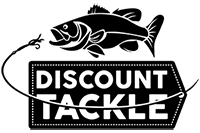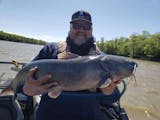
Fishing Line: Types & Uses
By Discount Tackle Staff
When it comes to tipping the odds of catching more fish in your favor, not many ways are as simple, effective, and affordable as making sure your reel is spooled with the best type of line for both the location you are fishing and your target species. While fishing line is not always the flashiest and most exciting aspect of tackle shopping, its role in fishing success cannot be understated. At Discount Tackle we stock a wide variety of fishing line and leader material for freshwater, saltwater, and brackish water fishing. So, whether you are fishing in open water or probing heavy cover, we're sure to carry a fishing line to suit your needs. Here are some of the common types of fishing line and their uses.
Monofilament Fishing Line
Monofilament, often known as mono, is a single strand of fishing line. It is typically made from one or multiple types of nylon. These nylon polymers are carefully extruded into one strong strand of finished material in different tensile strengths and diameters. These individual strands are then spun onto different sized spools, usually measured in meters or yards. Overall, monofilament fishing line is an affordable, all-around performer that casts quite well. Additionally, monofilament has a considerable amount of stretch to it, meaning it absorbs shock from fierce strikes extremely well. Most monofilament is also buoyant and will float to the surface on its own.
Berkley Trilene XL Monofilament, one of the oldest and most popular monofilament fishing lines on the market.
Monofilament fishing line is most often sold in a clear colored blend, but is also available in bright, high-visibility colors like yellow, orange, bright green and more, as well as more subtle natural colors like dark green. Note that even when extruded in a clear blend, monofilament is quite visible underwater because of its high diameter to pound test ratio (i.e., it takes a thicker strand of monofilament to achieve a given pound test than it does for other types of line). Another downside is that it is highly vulnerable to being damaged by UV rays and heat from prolonged sun exposure. There are also several different types and grades of polymers, just as there are many grades of nylon. So, the quality of the final product depends on which polymer a manufacturer uses.
Uses of Monofilament Fishing Line
Recall that monfilament's primary characteristics include it's ability to stretch, a floating buoyancy, and relative affordability when compared to other types of line. It's also quite easy to cast with and manage, so monofilament is a good mainline to start with for those new to fishing. Monofilament's stretch makes it a good choice for fishing for species that are hard striking, as the stretch can absorb the shock and decrease the chances of your rig breaking or the hook being ripped from the fish's mouth. Monofilament's buoyancy also makes it ideal for use with topwater lures and other near-surface baits.
Fluorocarbon Fishing Line
Fluorocarbon fishing line is a type of fishing line made from extruded fluoropolymers such as polyvinylidene fluoride (PVDF). This polymer blend has a refractive index almost identical to water, making it virtually invisible underwater. Fluorocarbon is also much denser than monofilament, meaning it is both thinner than monofilament at given pound test and has a sinking buoyancy. The density also contributes to increased abrasion resistance, making it less likely to break after coming in contact with rocks, timber, weeds, and pilings. Fluorocarbon is almost always produced in a clear blend, although some saltwater variations come in a light pink color. Fluorocarbon has very little stretch, meaning it is extremely sensitive. It also does not absorb water and therefore is not prone to damage from prolonged water exposure, although it can still be damaged by UV rays from long term sun exposure.
Seaguar InvizX Fluorocarbon, a premium fluorocarbon widely considered to be one of the stealthiest and most sensitive on the market.
Uses of Fluorocarbon Fishing Line
As a mainline, fluorocarbon can be somewhat difficult to manage and it is not recommend as a starter line for those new to fishing. That said, it is easy to use as a leader material for anglers of all skills levels and has a plethora of mainline advantages that intermediate and advanced anglers will appreciate.
For example, the stealth endowed to it by its water-like refractive properties makes it essential for fishing in super clear water. Additionally, because it sinks, another optimal application for fluorocarbon is fishing baits and lures that you want to get deep fast, like deep-diving crankbaits and jigs. It's thin diameter and sensitivity also makes it a great choice for throwing hard baits like jerkbaits where getting the correct action and lure motion is essential to success, as well as finesse baits, where the ability to detect light bites is important. Finally, because fluorocarbon is quite resistant to abrasion, it is a good choice if you are fishing around weeds, timber, pilings, and rocks.
It is also worth noting that because of its lack of stretch, fluorocarbon is rarely used as mainline for trolling because there is nothing to absorb the shock of a hard strike. That said, some companies have started producing special blends of fluorocarbon that have been modified for trolling applications to give trolling anglers the stealth and sensitivity of fluorocarbon without losing the stretch of monofilament.
Copolymer Fishing Line
Copolymer (or co-polymer) fishing line is any type of line made from two different polymers blended together (e.g., two different types of nylon or a mix or nylon and fluorocarbon). Generally speaking, copolymer fishing line is similar to plain old monofilament and you will often hear copolymer fishing line referred to as "copolymer monofilament." And while relatively new to the fishing scene, copolymer lines have significantly increased in popularity over the last few years in particular.
Different blends of copolymer line are often manufactured for specific applications. For example, it can be made more or less stretchy depending on the desired level of sensitivity and shock absorption capabilities required. The buoyancy of the line can also be altered, with some copolymers designed to sink while others float. This flexibility in traits and characteristic makes it easier to craft line designed specifically for various conditions, such as super-deep water or surface fishing. All told, copolymer lines also tend to have better abrasion resistance and can be thought of as “heavy-duty” or "enhanced" versions of normal monofilament lines.
Uses of Copolymer Fishing Line
Applications of copolymer line often vary by what the line is designed for, but broadly speaking copolymer fishing line is a great choice when you want to combine the advantages of monofilament and fluorocarbon. In other words, copolymer is often what you're looking for if you desire a line that has the stretch and/or buoyancy of monofilament, but more of the abrasion resistance and sensitivity of fluorocarbon.
Braided Fishing Line
Braided fishing line was originally spun from natural materials, such as cotton, silk, and linen, and have been around for a long time. However, these days mass-produced braid is almost exclusively made from space-age synthetic fibers such as Spectra, Dacron, IZANAS, and Dyeema that are precisely woven together by machines. This process creates a fishing line has almost zero memory and does not stretch. It is also the most abrasion resistant and often requires specialized, super-sharp scissors or line cutters to properly cut off the spool. Another amazing thing about braid is that can be dyed almost any color and can have multiple colors on the same spool. This allows for high visibility colors like fluorescent yellow or bright blue, subtle camouflage-like colors such as moss green, as well as multi-color lines that use alternating color patterns to help angler identify how much line they have let out.
Daiwa J-Braid Grand x8 Braided Line, a newer PE braided line made with IZANAS fibers.
Depending on how it is used, braided fishing line really only has two or three major downsides. The first is cost - quality braided fishing line can be considerably more expensive than monofilament. The second is it the line's lack of stealth in clear water. Unlike monofilament and fluorocarbon, which are translucent, braid is opaque and can be extremely visible in clear water. Finally, braid has no stretch whatsoever, which is desirable in some fishing situations, but a major disadvantage in others. The latter two characteristics mean the anglers rarely fish only braid, but instead fish braid as their mainline with a monofilament or fluorocarbon leader.
Uses of Braided Fishing Line
Braid is ideal for situations that require strong, abrasion resistant line with a small diameter. In freshwater, this makes it excellent for fishing in heavy vegetative cover and timber. Most braid floats in freshwater and is therefore good for topwater and near surface presentations when used in conjunction with a leader. Braid is also super sensitive, making it ideal for light finesse techniques. Braid is also easy to manage and works particularly well on spinning reels, so it's a great line choice for novice anglers who don't mind spending a few more bucks.
In saltwater fishing, the strength and reliability of braided line means it is used for nearly every major technique and presentation, including trolling, live bait, casting, jigging, and deep-dropping on all types of fishing reels. In fact, braid is so good at getting deep fast and cutting through current, it's the only effective mainline choice for deep drop fishing offshore.
Leaders
Maxima Clear Monofilament Leader Wheel, a small leader portion of Maxima's Clear Monofilament.
A leader is a short section of line that is different than your mainline that you tie between your mainline and your lure or bait rig. Leader material can be made from mainline materials like nylon monofilament, fluorocarbon, and copolymer, as well titanium or stainless steel. Many fishing line manufacturers even make specific blends of these of monofilament or fluorocarbon line specifically for use as leader. That said, mainlines manufactured from these materials can also be cut into short sections and used as leaders.
Leaders are often used to gain the advantages of that type of line close to your lure, while still retaining the advantages of your chosen mainline. For example, many bass finesse anglers like to use a light braided line with a fluorocarbon leader, as the braided mainline allows for sensitivity and line management, while the fluorocarbon leader offers extreme stealth.
Final Thoughts
Choosing the best type of fishing line for your needs is often all about understanding how each line differs and what it offers you. We recommend experimenting with different line types so you can find the best fit for any fishing technique or species. From monofilament and braided to fluorocarbon lines and with many options including color, and stretch, make sure that you do your research as well as try out a couple of different combinations in order to see what works well for you.






